#The Autobiography of Martin Luther King Jr
Text
I was the only Negro passenger on the plane, and I followed everybody else going into the Dobbs House to get lunch. When I got there one of the waiters ushered me back and I thought they were giving me a very nice comfortable seat with everybody else and I discovered they were leading me to a compartment in the back. And this compartment was around you, you were completely closed in, cut off from everybody else, so I immediately said that I couldn’t afford to eat there. I went on back and took a seat out in the main dining room with everybody else and I waited there, and nobody served me. I waited a long time, everybody else was being served. So finally I asked for the manager and he came out and started talking, and I told him the situation and he talked in very sympathetic terms. And I never will forget what he said to me.
He said, “Now Reverend, this is the law; this is the state law and the city ordinance and we have to do it. We can’t serve you out here but now everything is the same. Everything is equal back there; you will get the same food; you will be served out of the same dishes and everything else; you will get the same service as everybody out here.”
And I looked at him and started wondering if he really believed that. And I started talking with him. I said, “I don’t see how I can get the same service. Number one, I confront aesthetic inequality. I can’t see all these beautiful pictures that you have around the walls here. We don’t have them back there. But not only that, I just don’t like sitting back there and it does something to me. It makes me almost angry. I know that I shouldn’t get angry. I know that I shouldn’t become bitter, but when you put me back there something happens to my soul, so that I confront inequality in the sense that I have a greater potential for the accumulation of bitterness because you put me back there. And then not only that, I met a young man from Mobile who was my seat mate, a white fellow from Mobile, Alabama, and we were discussing some very interesting things. And when we got in the dining room, if we followed what you’re saying, we would have to be separated. And this means that I can’t communicate with this young man. I am completely cut off from communication. So I confront inequality on three levels: I confront aesthetic inequality; I confront inequality in the sense of a greater potential for the accumulation of bitterness; and I confront inequality in the sense that I can’t communicate with the person who was my seat mate.”
And I came to see what the Supreme Court meant when they came out saying that separate facilities are inherently unequal. There is no such thing as separate but equal.
The Autobiography of Martin Luther King Jr.
#MLK#Martin Luther King Jr#Clayborne Carson#The Autobiography of Martin Luther King Jr#1960s#civil rights#civil rights movement#black history#black history month#black lives matter#black history matters#black authors#history#blm#black voices#bipoc#african american#peaceful protests#nonviolent resistance#atypicalreads#noncooperation#passive resistance
529 notes
·
View notes
Text
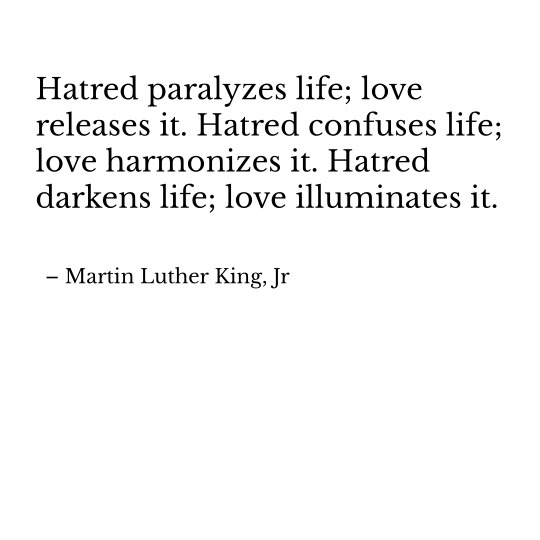
– Martin Luther King, Jr., A Testament of Hope: The Essential Writings and Speeches
James Melvin Washington(Editor)
#book quote of the day#martin luther king jr#a testament of hope#nonfiction#autobiography#essays#interviews#race#social justice#non-violence#book recs
1 note
·
View note
Text
https://www.washingtonpost.com/history/2023/05/10/mlk-malcolm-x-playboy-alex-haley/

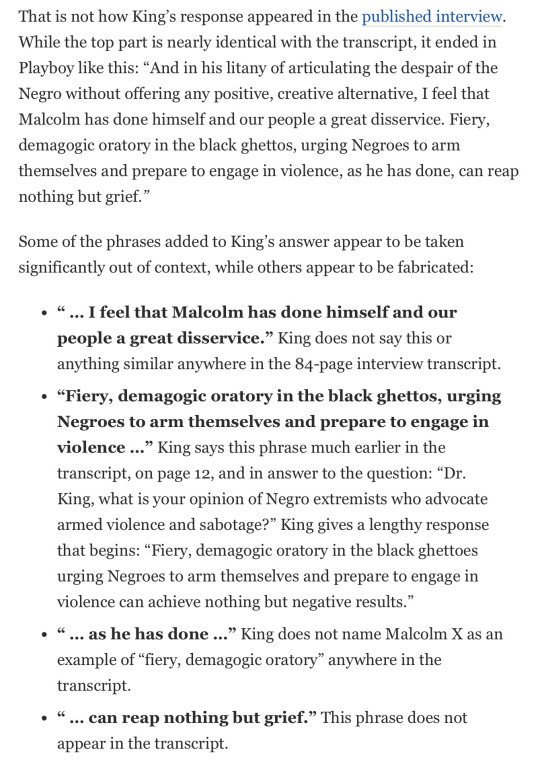
Jonathan Eig was deep in the Duke University archives researching his new biography of Martin Luther King Jr. when he made an alarming discovery: King’s harshest and most famous criticism of Malcolm X, in which he accused his fellow civil rights leader of “fiery, demagogic oratory,” appears to have been fabricated.
“I think its historic reverberations are huge,” Eig told The Washington Post. “We’ve been teaching people for decades, for generations, that King had this harsh criticism of Malcolm X, and it’s just not true.”
The quote came from a January 1965 Playboy interview with author Alex Haley, a then-43-year-old Black journalist, and was the longest published interview King ever did. Because of the severity of King’s criticism, it has been repeated countless times, cast as a dividing line between King and Malcolm X. The new revelation “shows that King was much more open-minded about Malcolm than we’ve tended to portray him,” Eig said.
Haley’s legacy has been tarnished by accusations of plagiarism and historical inaccuracy in his most famous book, “Roots,” but this latest finding could open up more of his work to criticism, especially “The Autobiography of Malcolm X: As Told to Alex Haley” — released nine months after Malcolm X’s assassination in 1965.
Malcolm X, a member of the Nation of Islam, had frequently attacked King and his commitment to nonviolence, going so far as to call King a “modern Uncle Tom.” But his criticism often had “strategic purposes,” Eig said.
In acting as “a foil” to King, his message had more value to the media. “King saw value in being a foil to Malcolm sometimes, too. But I think at their core they had a lot in common. They certainly shared a lot of the same goals,” Eig said.
Eig, who previously wrote acclaimed biographies of Muhammad Ali and Lou Gehrig, said he found the fabrication in the course of his standard book research for “King: A Life,” due out May 16. When a subject has given a long interview, he’ll look through the archives of the journalist who conducted it, hoping to find notes or tapes with previously unpublished anecdotes.
He did not find a recording of Haley’s interview with King in the Haley archives at Duke, but he did find what appears to be an unedited transcript of the full interview, likely typed by a secretary straight from a recording, Eig said. Eig provided The Post with a copy of the transcript.
On page 60 of the 84-pagedocument, Haley asks, “Dr. King, would you care to comment upon the articulate former Black Muslim, Malcolm X?”
King responds: “I have met Malcolm X, but circumstances didn’t enable me to talk with him for more than a minute. I totally disagree with many of his political and philosophical views, as I understand them. He is very articulate, as you say. I don’t want to seem to sound as if I feel so self-righteous, or absolutist, that I think I have the only truth, the only way. Maybe he does have some of the answer. But I know that I have so often felt that I wished that he would talk less of violence, because I don’t think that violence can solve our problem. And in his litany of expressing the despair of the Negro, without offering a positive, creative approach, I think that he falls into a rut sometimes.”
That is not how King’s response appeared in the published interview. While the top part is nearly identical with the transcript, it ended in Playboy like this: “And in his litany of articulating the despair of the Negro without offering any positive, creative alternative,I feel that Malcolm has done himself and our people a great disservice. Fiery, demagogic oratory in the black ghettos, urging Negroes to arm themselves and prepare to engage in violence, as he has done, can reap nothing but grief.”
Some of the phrases added to King’s answer appear to be taken significantly out of context, while others appear to be fabricated:
@meanmisscharles @russianspacegeckosexparty @ubernegro @that-biracial-geek-girl @redstarovermoundcity
Eig has shared this discovery with a number of King scholars, and the changes “jumped out” to them as “a real fraud,” Eig said. “They’re like, ‘Oh my God, I’ve been teaching that to my students for years,’ and now they have to rethink it,” Eig said.
5K notes
·
View notes
Text
youtube
“I had a real reason for running,” Gillespie wrote in his autobiography, “because the proceeds from the sale of buttons went to CORE, SCLC [the Southern Christian Leadership Conference] and Dr. Martin Luther King, Jr., and I could threaten Democrats with a loss of votes and swing them to a more reasonable position on civil rights.”
19 notes
·
View notes
Text

Michael Babatunde Olatunji (April 7, 1927 – April 6, 2003) was a Nigerian drummer, educator, social activist, and recording artist.
He was born in the village of Ajido in southwestern Nigeria. A member of the Ogu people, he was introduced to traditional African music at an early age. His name, Bàbátúndé, means ‘father has returned’, because he was born two months after his father, Zannu died, and he was considered to be a reincarnation. His father was a local fisherman who was about to rise to the rank of chieftain, and his mother was a potter who was a member of the Ogu people. He grew up speaking the Gun (Ogu/Egun) and Yoruba languages. He was groomed to take the position of chief.
When he was 12, he realized that he did not want to become a chieftain. He read in Reader’s Digest magazine about the Rotary International Foundation’s scholarship program and applied for it. His application was successful and he went to the US in 1950.
He received a Rotary scholarship in 1950 and was educated at Morehouse College. He was a good friend of Glee Club director Dr. Wendell P. Whalum and collaborated with him on a staple of the choir’s repertoire, “Betelehemu”. After graduating from Morehouse, he went on to New York University to study public administration. He started a small percussion group to earn money on the side while he continued his studies.
He composed music for the Broadway theatrical and the 1961 Hollywood film productions of Raisin in the Sun. He assisted Bill Lee with the music for She’s Gotta Have It.
He was known for making an impassioned speech for social justice before performing in front of a live audience. His progressive political beliefs are outlined in The Beat of My Drum: An Autobiography. He toured the South with Rev. Martin Luther King Jr. and joined King in the March on Washington.
He performed before the UN General Assembly. He was one of the first outside performers to perform in Prague. On July 21, 1979, he appeared at the Amandla Festival. #africanhistory365 #africanexcellence
4 notes
·
View notes
Text
🪶🪶𝐌𝐚𝐲𝐚 𝐀𝐧𝐠𝐞𝐥𝐨𝐮 (𝟏𝟗𝟐𝟖 - 𝟐𝟎𝟏𝟒)
She was a renowned poet, novelist, and memoirist. She is best known for her autobiography, "I Know Why the Caged Bird Sings," which became a seminal work in African American literature.
Maya Angelou's life and writings reflected her experiences as a black woman in America, and her works explored themes of race, identity, and empowerment. Her autobiography, published in 1969, chronicled her early years, including her childhood in the racially segregated South and the challenges she faced growing up. The book received critical acclaim for its honest portrayal of her personal journey and its commentary on the larger issues of racism and social injustice.
Throughout her career, Maya Angelou's literary contributions extended beyond her autobiography. She published numerous volumes of poetry, including "And Still I Rise" and "Phenomenal Woman," which celebrated the resilience and beauty of black women. Her powerful and evocative poetry resonated with readers around the world and became an integral part of the African American literary canon.
In addition to her writing, Maya Angelou was also a prominent civil rights activist and advocate for social change. She worked closely with notable figures such as Martin Luther King Jr. and Malcolm X, lending her voice and support to the fight for racial equality. Her activism took various forms, including public speaking engagements, organizing events, and participating in demonstrations.
Maya Angelou's legacy is one of resilience, courage, and empowerment. Through her words and actions, she championed the rights and dignity of black women, and her contributions to literature and social justice continue to inspire generations of readers and activists.

16 notes
·
View notes
Note
Playlists???? 👀👀👀👀
For Youthful Exuberance?
Also, do you have a Clancy playlist??? 👀
Ahhh, I’m so excited you asked, @emilie786! ❤️ Thank you!
Youthful Exuberance (Pikeuna, E), has three playlists for a total of three hours of music. (This fic lived in my bones.) Some highlights:
So This is Love (Cinderella), of course, for Chris and Una’s first kiss: “So this is love, mmm, So this is love, So this is what makes life divine … My heart has wings, mmm, And I can fly, I’ll touch every star in the sky”
San Francisco (Cascada) for Starfleet Academy vibes: “Poppin’ some bottles, champagne, red wine, And we both giddy up on the rooftop, And watch the city lights, Tell me what you’re waitin’ for, (We’re crossing the Golden Gate, Party at the Frisco Bay)” — I had already written the rooftop date when I found this song so I was very 👀👀😍 about that coincidence
Call You Mine (The Chainsmokers) for the cracks — and love — in Chris and Una’s early relationship: “Think about what you believe in now, Am I someone you cannot live without? ‘Cause I know I don’t want live without you, Yeah, Come on let’s turn this all around, Bring it all back to that bar downtown, When you wouldn’t let me walk out on you, Yeah” (again, I found the song after I wrote the part with the bar)
I’ll Follow (ROZES) for more early relationship: “Shoes by the door, And your coat in the closet hallway, You hung your keys, And I knew in that moment you’d stay, You built your bed in my heart and now that’s where you lay, And the sycamore by the river is where our children will play”
When Love Takes Over (David Fuetta featuring Kelly Rowland) for overall vibes: “It’s complicated, It always is, That’s just the way it goes, Feels like I’ve waited so long for this, I wonder if it shows, Head underwater, Now I can’t breathe, It never felt so good, ‘Cause I can feel it coming over me, I wouldn’t stop it if I could, When love takes over, yeah, You know you can’t deny, When love takes over, yeah, ‘Cause something’s here tonight”
Love Somebody (Maroon 5) for Chris worrying about Una when he’s on the Antares and she’s on the Martin Luther King Jr.: “I know we’re only halfway there, But you can take me all the way, you can take me all the way … I think about you every single day … I wanna feel like we’re never ever gonna stop”
What Do You Want from Me? (Cascada) for when Una takes her big risk with Chris on the Antares: “Just tell me, what do you want from me? This is love in the first degree … It’s not too late, now we’re standing face to face, And heaven is the only place, will you understand?”
Playground (Cascada) for service together and the, uh, end of the story: “Sirens ringing bright, They’re taking us to another high, And our hearts are driven wild, You and I both read the signs … Your heart is my playground.”
And Clancy! Oh my goodness, I also have three playlists for a total of three hours of music for The Autobiography of Kirsten Clancy (Gen, T). Again, some highlights:
Believe (Cher) for vibes and Clancy’s righteous anger toward Jean-Luc Picard for walking out on Starfleet when Starfleet needed him: “No matter how hard I try, You keep pushing me aside, And I can’t break through, There’s no talking to you.”
I Think We’re Alone Now (Tiffany) for meeting Matthew Clancy: “Running just as fast as we can, Holdin’ on to one another’s hand, Tryin’ to get away into the night, And then you put your arms around me, And we tumble to the ground, and then you say, I think we’re alone now”
Dancing in the Dark (Bruce Springsteen) for fighting in the Dominion War: “You can’t start a fire, You can’t start a fire without a spark, This gun’s for hire, Even if we’re just dancing in the dark”
Rhythm of the Night (DeBarge) for the holodeck parties Clancy took her kids to during the Dominion War: “When it feels like the world is on your shoulders, And all of the madness has got you going crazy, It’s time to get out, step out into the street, Where all of the action is right there at your feet, Well, I know a place where we can dance the whole night away, Underneath electric stars, Just come with me and we can shake your blues right away, You’ll be doing fine once the music starts, oh”
Take Me Home Tonight (Eddie Money) for Matthew Clancy’s pain after the Dominion War: “I get frightened in all this darkness, I get nightmares, I hate to sleep alone, I need some company, a guardian angel, To keep me warm when the cold winds blow”
4 Minutes (Madonna featuring Justin Timberlake) for heroism Clancy doesn’t remember in the Breen prison camp: “Time is waiting, We only got 4 minutes to save the world, No hesitating, We only got four minutes”
Power of Two (Indigo Girls) for old Kirsten and Matthew working at Starfleet Command and going home together at the end of the day: “So we’re okay, we’re fine, Baby, I’m here to stop your cryin’, Chase all the ghosts from your head, I’m stronger than the monster beneath your bed, Smarter than the tricks played on your heart, We’ll look at them together, then we’ll take ‘em apart, Adding up the total of a love that’s true, Multiply life by the power of two”
Thank you again for asking, @emilie786! ❤️ I tried to cull the lists so it wasn’t too much. 🙈
Send me a fic and I’ll tell you a song (or highlights from a playlist) from when the story was banging around in my brain.
#i love asks#fic songs#youthful exuberance#the autobiography of kirsten clancy#thank you again for asking#emilie786
3 notes
·
View notes
Text
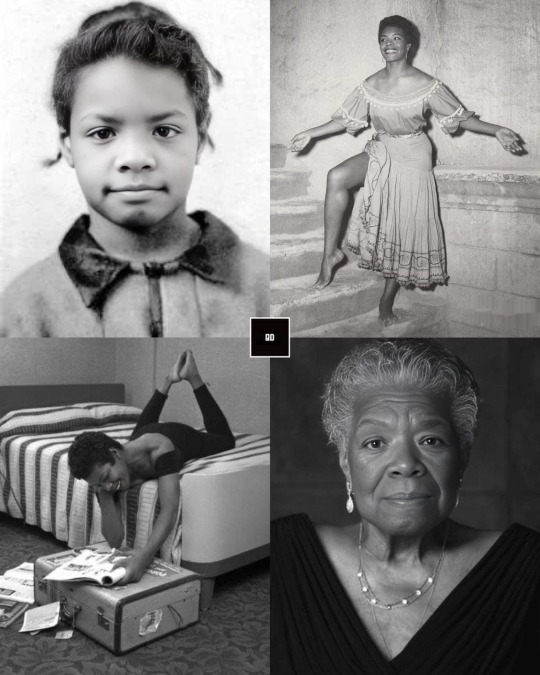
Gone But Never Forgotten! We Remember Maya Angelou On Her Birthday!
(April 4, 1928 – May 28, 2014)
Marguerite Annie Johnson was an American memoirist, poet, and civil rights activist. She published seven autobiographies, three books of essays, several books of poetry, and is credited with a list of plays, movies, and television shows spanning over 50 years. She received dozens of awards and more than 50 honorary degrees. Angelou's series of seven autobiographies focus on her childhood and early adult experiences. The first, I Know Why the Caged Bird Sings (1969), tells of her life up to the age of 17 and brought her international recognition and acclaim.
She became a poet and writer after a string of odd jobs during her young adulthood. These included fry cook, sex worker, nightclub performer, Porgy and Bess cast member, Southern Christian Leadership Conference coordinator, and correspondent in Egypt and Ghana during the decolonization of Africa. Angelou was also an actress, writer, director, and producer of plays, movies, and public television programs. In 1982, she was named the first Reynolds Professor of American Studies at Wake Forest University in Winston-Salem, North Carolina. Angelou was active in the Civil Rights Movement and worked with Martin Luther King Jr. and Malcolm X. Beginning in the 1990s, she made approximately 80 appearances a year on the lecture circuit, something she continued into her eighties. In 1993, Angelou recited her poem "On the Pulse of Morning" (1993) at the first inauguration of Bill Clinton, making her the first poet to make an inaugural recitation since Robert Frost at the inauguration of John F. Kennedy in 1961.
With the publication of I Know Why the Caged Bird Sings, Angelou publicly discussed aspects of her personal life. She was respected as a spokesperson for Black people and women, and her works have been considered a defense of Black culture. Her works are widely used in schools and universities worldwide, although attempts have been made to ban her books from some U.S. libraries. Angelou's most celebrated works have been labeled as autobiographical fiction, but many critics consider them to be autobiographies. She made a deliberate attempt to challenge the common structure of the autobiography by critiquing, changing and expanding the genre. Her books center on themes that include racism, identity, family and travel.
5 notes
·
View notes
Text
Answer the questions and tag some people you want to know better or catch up with!
Tagged by: @spinteresting hehe thank you for the tag 🥰🥰
Last song listened to: Rule #4- Fish in a Birdcage
Currently reading: the autobiography of Martin Luther King Jr. sooooo fun fact I’m a huge history nerd ahdhdh, and I just finished my book on the history of Russia (which was a huge beast to get through I spent a year reading it istg)
Currently watching: ofmd season 2 babyyyyy!! I would love to say I’m watching other stuff but I’ve mostly been rewatching shows or movies whilst waiting for the new episodes ahshdh
Currently obsessed with: hehe you mean besides Izzy and Frenchie, I’m actually really enjoying twisted wonderland’s masquerade event right now 😈
Tagging: @changethecircumstances @captainrexshusband @whalenagain I’m bad at tagging so also anyone else who wants to do it 😌
3 notes
·
View notes
Text

Tony Bennett, Enraged By Racism, Championed Civil Rights Alongside Martin Luther King Jr.
In the 1950s, Tony Bennett watched with dismay as Black musicians like Nat King Cole and Duke Ellington were denied admission to concert hall dining rooms and hotels. The injustice he witnessed infuriated the young singer.
"I'd never been politically inclined, but these things went beyond politics," Bennett wrote in "The Good Life," his 1998 autobiography. "Nate and Duke were geniuses, brilliant human beings who gave the world some of the most beautiful music it's ever heard, and yet they were treated like second-class citizens. The whole situation enraged me."
That's why, when the artist and activist Harry Belafonte called up Bennett and asked him to join the Rev. Martin Luther King Jr.'s voting rights march from Selma to Montgomery in 1965, Bennett accepted without hesitation. He flew to Alabama and linked arms with his allies in the fight for justice.
"When the march started, I had a strange sense of déjà vu," Bennett wrote in his 304-page autobiography. "I kept flashing back to a time twenty years earlier when my buddies and I had fought our way into Germany." Serving in World War II, Bennett's friendship with a Black servicemen was condemned by white Army officers.
"It felt the same way down in Selma: the white state troopers were really hostile, and they were not shy about showing it.”
Bennett was "terrified," he recalled, but Belafonte "kept his cool" and helped make sure everyone focused on the road ahead.
Bennett then went ahead to Montgomery so he could be there on March 24 to greet King and sing for the marchers alongside Ella Fitzgerald, Pete Seeger, Joan Baez, Sammy Davis Jr., Mahalia Jackson and others.
“I’m enormously proud that I was able to take part in such a historic event, but I’m saddened to think that it was ever necessary and that any person should suffer simply because of the color of his skin.” -(source: nbc news)
DNA America
“it’s what we know, not what you want us to believe.”
#dna #dnaamerica #news #politics
3 notes
·
View notes
Text
“It must be remembered that genuine peace is not the absence of tension, but the presence of justice.” — Martin Luther King Jr.
#MLK#Martin Luther King Jr#Clayborne Carson#The Autobiography of Martin Luther King Jr#1960s#civil rights#civil rights movement#black history#black history month#black lives matter#black history matters#black authors#history#blm#black voices#bipoc#african american#peaceful protests#nonviolent resistance#atypicalreads#noncooperation#passive resistance
187 notes
·
View notes
Text
CHRONOLOGY OF AMERICAN RACE RIOTS
AND RACIAL VIOLENCE p-4
1947
Congress of Racial Equality (CORE) and the Fellowship of Reconciliation (FOR) join forces in the Journey of Reconciliation, a precursor to the Freedom Rides, which tested a Supreme Court decision declaring segregation on interstate buses to be unconstitutional.
1948
Publication of Walter White’s autobiography A Man Called White.
1949
August–
September
Peekskill, New York, riots.
1954
May U.S. Supreme Court renders decision in Brown v. Board of Education case, declaring a segregated educational system to be ‘‘inherently unequal.’’
July Robert Patterson founds the White Citizens’ Council in Indianola, Mississippi.
1955
Queen Mother Audley Moore founds the Reparations Committee of Descendants of the United States Slaves.
Foundation of the Southern Christian Leadership Conference (SCLC), a southern-based civil rights organization led by Dr. Martin Luther King, Jr., and other black ministers.
August Fourteen-year-old Emmett Louis Till, an African American boy from Chicago, is murdered for allegedly whistling at a white woman.
1956–1971
The FBI Counter Intelligence Program (COINTELPRO) investigates and disrupts dissident domestic organizations, including civil rights groups.
1957
September President Dwight D. Eisenhower signs the Civil Rights Act of 1957, the first piece of civil rights legislation since Reconstruction.
1959
February Mack Charles Parker is lynched in Mississippi for allegedly raping a white woman.
1960
February Four black college students stage a ‘‘sit-in’’ at Woolworth’s whites-only lunch counter in Greensboro, North Carolina.
Student Nonviolent Coordinating Committee (SNCC) is founded.
April Biloxi Beach, Mississippi, riot.
1961
May First Freedom Ride.
1962
Harlem Youth Opportunities Unlimited (HARYOU) is founded.
Robert F. Williams publishes Negroes with Guns, exploring Williams’ philosophy of black self-defense.
October Two die in riots when President John F. Kennedy sends troops to Oxford, Mississippi, to allow James Meredith to become the first African American student
to register for classes at the University of Mississippi.
1963
Publication of The Fire Next Time by James Baldwin.
Revolutionary Action Movement (RAM) is founded.
April Rev. Martin Luther King, Jr., writes his ‘‘Letter from Birmingham Jail.’’
2 notes
·
View notes
Photo


Summer in Connecticut About 15,000 years ago, toward the end of the last ice age, a large glacial lake (Lake Hitchcock) covered much of the Connecticut River Valley, from central Connecticut to northern Vermont. The fine layers of silt, sediment, and sand deposited on the lake floor—and later sorted and sculpted by wind and glacial meltwater streams—form the base of the sandy loam soils that still line the Connecticut River Valley today. It was the presence of these fertile “Windsor soils” that turned the valley into a hub of shade tobacco production for use in cigars, and ultimately what brought Martin Luther King Jr. to Connecticut as a teenager. In one of his first extended trips away from Georgia and his family, King and other students from Morehouse College worked summers on a tobacco farm in Simsbury, Connecticut, in 1944 and 1947 to earn money for tuition. The Operational Land Imager-2 (OLI-2) on Landsat 9 captured this image of Simsbury on September 15, 2022. The tobacco farm where King worked—Meadowood—is located west of the Farmington River, a tributary of the Connecticut River. The photograph below, taken by the U.S. Fish & Wildlife Service, shows aging tobacco barns on the edge of the Meadowood property. While the tobacco industry has largely disappeared and housing developments have spread, plenty of farmland and tobacco barns remain, including some that are visible in the Landsat image. In recent years, a large solar plant located on nearby farmland has started to generate power. A nursery north of Meadowood has large numbers of greenhouses and row covers, which have some parallels to the shade coverings that would have been common when King spent time in the area. King’s time in Connecticut impacted his outlook and trajectory as a minister and civil rights activist, according to King scholars. It was his first experience away from the strict segregation of the Deep South. “On the way here, we saw things I never anticipated to see,” he wrote in a letter to his father after arriving in Simsbury. “After we passed Washington, [there] was no discrimination at all. …We go to any place we want to and sit any where [sic] we want to.” In a letter to his mother, King wrote about the simplicity of a trip to nearby Hartford: “I never thought that a person of my race could eat anywhere but we ate in one of the finest restaurant[s]. …And we went to the largest shows there.” It was during his first summer in Simsbury that King first took a leadership role in church, leading Sunday services for the 107 other students in his dorm and the place where he resolved to pursue a career as a minister. The taste of desegregation stayed with King. “After that summer in Connecticut, it was a bitter feeling going back to segregation,” he later wrote in his autobiography. “It was hard to understand why I could ride wherever I pleased on the train from New York to Washington and then had to change to a Jim Crow car at the nation’s capital in order to continue the trip to Atlanta.” For decades, little was known about King’s time in Simsbury. A group of Simsbury high school students helped bring it to light by conducting local historical research and producing an influential documentary that was released in 2010. In 2021, the town of Simsbury, with the support of the U.S. Fish & Wildlife Service and other partners, acquired the farmland where King worked and plans to preserve it. NASA Earth Observatory image by Joshua Stevens, using Landsat data from the U.S. Geological Survey. Photo by Tricia Andriski (USFWS). Story by Adam Voiland.
3 notes
·
View notes
Text
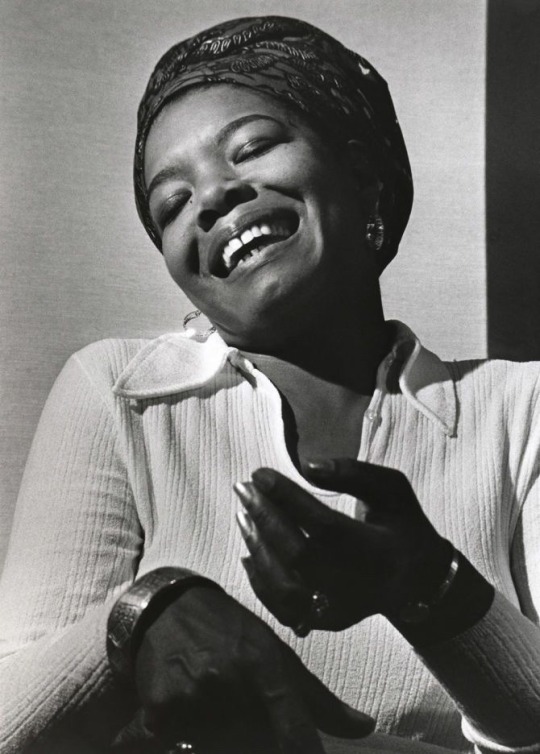
Phenomenal Woman Maya Angelou
Maya Angelou was born on April 4, 1928 in St. Louis, Missouri. Maya’s grandmother was a safe haven for her, where she lived mostly up until the age of 13 in Arkansas. Around the age of 7, Maya was sexually assaulted by a friend of the family. After she confessed to her uncle about who did it, he was found dead shortly afterwards. The trauma of the occurrence led Maya to become mute for years. She was afraid her voice would cause more harm than good. A fellow teacher that visited her grandmother's store took Maya to the school library and told her to read all of the books in that room.


Maya began her exploration of literature and found delight in poetry especially. Her teacher told her she could only truly love poetry once she began to speak and experience the words. Maya began memorizing her favorite poems. Her favorite poet was Paul Dunbar. The title of her first publication, “I Know Why the Caged Bird Sings” comes from the inspiration of his poem. The book is an autobiography about her childhood and is the first nonfiction best seller by an African American woman. It was poetry where Maya discovered the beauty and power of words, but life would show her ugliness and pain.
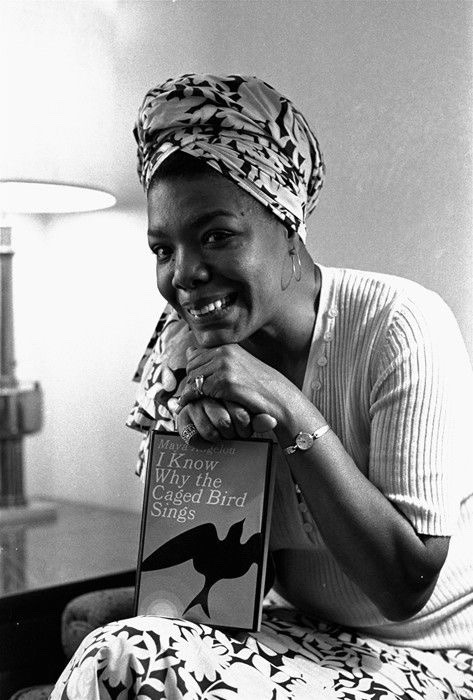
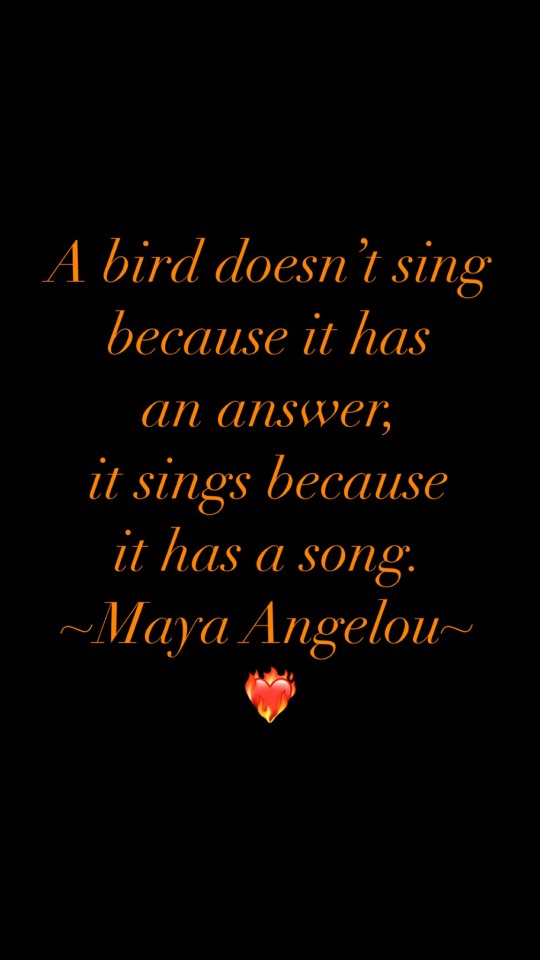
At the age of 14 Maya received a scholarship to California Labor School , where she studied drama and dance at night, while still attending high school during the day. At the age of 16 Maya gave birth to her son. After high school Maya went from a struggling teen mom to a fulfilled artist. Around the age of 20 Maya was teaching dance and performing as a singer. She is well known for her calypso dancing and in 1957 released her first album Miss Calypso. In 1977 Maya received an Emmy Award nomination for her work on the TV miniseries Roots. In 1978 she published one of her famous collections of poetry, “And Still I Rise”, which features the beloved poem “Phenomenal Woman”.
youtube
Maya became more politically engaged and began working with the civil rights activist Martin Luther King Jr. She spent years in Egypt and Ghana where she taught in the University department of Music and Drama, as well as a feature editor and journalist for the African Review. Another autobiographical work, “A Song Flung Up to Heaven'' (2002) explores her return from Africa to the U.S, and her struggles with the assassinations of two great human rights activists Malcom X and her friend Martin Luther King. MLK’s assasination occurred on her birthday, April 4,1968. For many years she would not celebrate her birthday and continued to send flowers to his widow Coretta Scott King.
youtube
Maya became good friends with Oprah Winfrey, and Oprah hosted several great birthday celebrations, including a cruise for her 70th birthday. In 1998 Maya performed one of her most famous works for the inaugural ceremony of president Bill Clinton. The audio version of the poem “On the Pulse of Morning” (1993) lead Maya to winning a Grammy Award for best spoken word album. In 2014, Maya Angelou passed away in her home in North Carolina. Her legacy will forever remain. The phenomenal woman Maya Angelou has made artistic impact as a poet, writer, activist, and entertainer. Maya was all of these.
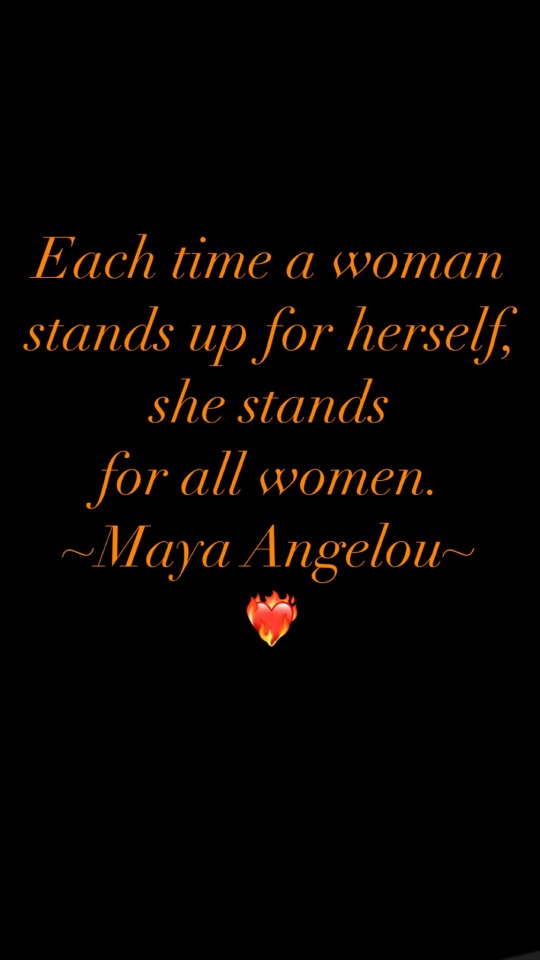
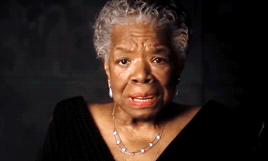
REFERENCES
B. (2021, May). Maya Angelou. Biography.
https://www.biography.com/writer/maya-angelou
Maya Angelou - One On One (1983). (2019, April 28). YouTube. https://www.youtube.com/watch?v=ye1mep8h7GA&feature=youtu.beMaya Angelou timeline. (1928, April 4). World History Project. https://worldhistoryproject.org/topics/maya-angelou
youtube
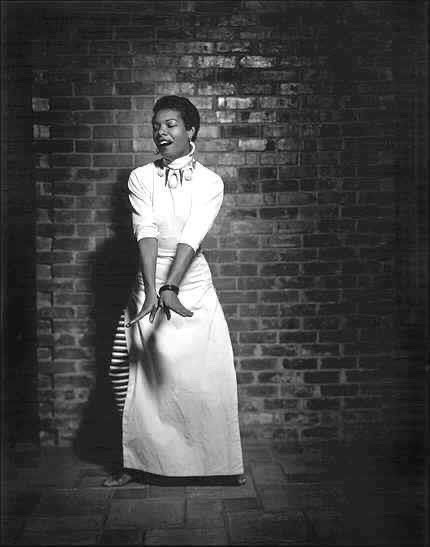
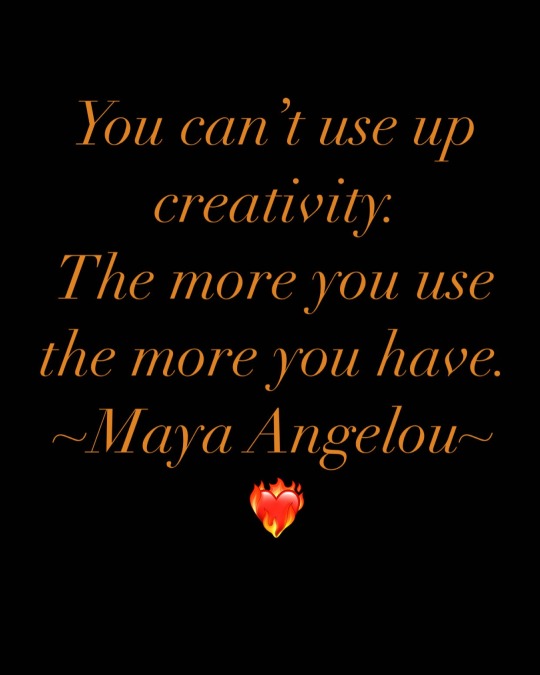
#maya Angelou#black female poet#civil rights#activist#black feminist#i know why the caged bird sings#lovefya#quote blog#Spotify#Youtube
11 notes
·
View notes
Photo
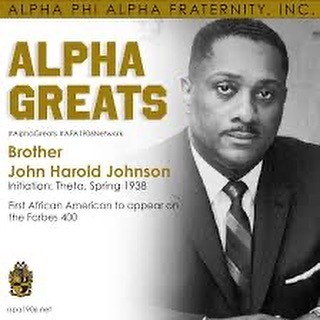
John Harold Johnson (January 19, 1918 – August 8, 2005) born in Arkansas City, was a publisher, philanthropist, businessman, and entrepreneur. He became the leading 20th Century publisher of African American news magazines. He moved to Chicago in 1932 where he attended school and graduated with honors. He attended the University of Chicago and Northwestern University but did not complete his degree. Over his lifetime, he received numerous honorary degrees. After working varied jobs and with $500.00 derived from mortgaging his mother’s furniture, he sold subscriptions and with the proceeds published Negro Digest. He started Ebony, a magazine. In 1951 he began publishing Jet magazine, a weekly periodical that reported news and developments relevant to African Americans. To oversee his publications he created Johnson Publishing Company in a small office in South Chicago and moved to a larger building in downtown Chicago in 1971. The Magazine Publishers Association elected him “Magazine Publisher of the Year.” He became the first African American to appear on the Forbes list of wealthiest Americans. His empire combined publishing, cosmetics, and insurance. In 1996 President Bill Clinton awarded him the Presidential Medal of Freedom. He was a member of Alpha Phi Alpha and Sigma Pi Phi Fraternities. One of the largest black-owned businesses in the US, Johnson Publishing Company was a major producer of African American magazines that focused on the accomplishments of African Americans. Providing a much-needed forum for African Americans and with a national scope, these magazines explored issues, reported events, and discussed people as they related to the needs and concerns of African Americans. He became involved in politics and the civil rights movement. He supported Martin Luther King, Jr., thoroughly reported civil rights efforts, befriended Jesse Jackson, and was a benefactor of Howard University. He encouraged and applauded African American successes while reporting their problems. His life, as he viewed it, can be glimpsed in his best-selling autobiography, Succeeding Against the Odds. #africanhistory365 #africanexcellence #alphaphialpha #sigmpiphi https://www.instagram.com/p/CnmD8mvuDr1/?igshid=NGJjMDIxMWI=
3 notes
·
View notes
Text
The Reverberations: Cori Bush's Resolute Campaign for Re-Election
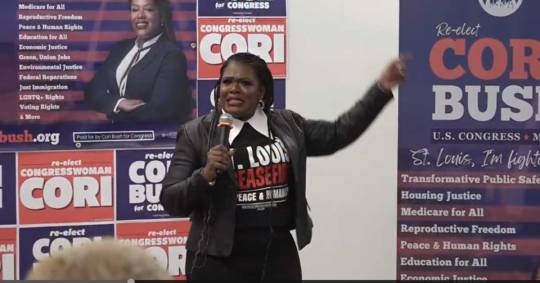

the Reverberations Cori Bush's Resolute Campaign for Re-Election
Amidst the Northwoods' strip mall backdrop, a multitude gathered fervently to endorse the imminent political journey of a local ordained minister. This unconventional assembly, akin to a religious congregation, united Christians, Jews, Muslims, and agnostics in a progressive cause rather than a conventional faith.
Noteworthy figures adorned video screens, featuring quotes from influential leaders such as Baptist minister Dr. Martin Luther King Jr., civil rights advocate Fannie Lou Hamer, revolutionary activist Angela Y. Davis, and former U.S. Rep. Shirley Chisholm, the first Black woman elected to Congress.
The assembly echoed chants popularized by Assata Shakur, a Black Panther Party member, as they passionately declared their duty to fight for freedom and mutual support. A poignant moment arose when a skilled musician, Katarra Parson, expressed gratitude to Cori Bush, evoking emotions with a rendition of Andra Day's "Rise Up," drawing attention to Bush's impactful addresses in Congress.
U.S. Rep. Rashida Tlaib, Bush's guest speaker and a member of the progressive 'Squad,' delved into her own humble beginnings, drawing contrasts with wealthier colleagues and critiquing policy decisions. The progressive duo criticized the Biden administration's Gaza policy, intertwining foreign policy expenses with domestic program deficits.
Externally, a truck circled, highlighting the irony of allocating funds for overseas conflicts while domestic issues persist. Internally, Bush, donning a 'Ceasefire' t-shirt, justified her wardrobe choices, asserting her commitment to conveying messages effectively.
Bush, a registered nurse and ordained minister, emerged onto the political stage following Michael Brown's death in Ferguson. Reflecting on past election cycles, she anticipates heightened financial opposition in her bid for re-election, predicting her opponent's substantial fundraising.
In a pre-emptive move, Bush prepared her followers to discern truth from misleading campaign tactics, urging them to reject falsehoods disseminated through various mediums.
Facing a formidable challenge from St. Louis County Prosecutor Wesley Bell, Bush used her platform to scrutinize the allocation of funds for the Israeli military campaign. Despite potential financial setbacks, her loyal base remains a stronghold against Bell's campaign.
Within the assembly, Bush was revered as a moral compass, championing causes even when uncomfortable, a sentiment echoed by President of the St. Louis Board of Aldermen Megan Green.
Bush embraced the term 'radical,' asserting that societal exploitation necessitates a protest. She redirected attention to domestic needs, emphasizing the rechanneling of funds from overseas conflicts to local issues.
Acknowledging the strains within the Democratic party, Bush shared her struggle with divisive calls and expressed nostalgia for her private life. Undeterred by the sacrifices, she reiterated her commitment to her calling, symbolized in her autobiography, "The Forerunner."
The official campaign messaging downplayed doctrinal themes, but the passionate words of a supporter on social media revealed a more fervent perspective.
Bush criticized the American Israel Public Affairs Committee (AIPAC), attributing opposition to dark money influence. She clarified her stance against supremacy, emphasizing equality and rejecting the notion of anti-Semitism.
In the eyes of her supporters, Bush's past experiences and dedication make her a beacon of understanding, someone they entrust with their traumas and pain.
In essence, the article captures the intricate tapestry of Bush's re-election campaign, reflecting the diverse and impassioned voices that rally behind her cause.
Read the full article
0 notes